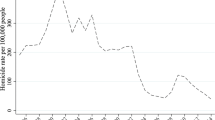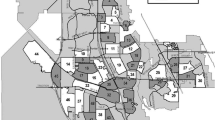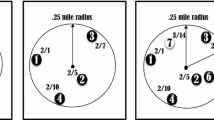Abstract
Objectives
This randomized experiment explored the impact of hot spots policing (HSP) strategies on criminal offenses and calls for service within chronic, persistent violent crime clusters in Las Vegas, NV.
Methods
Forty-four street segments were randomized into treatment (N = 22) and control (N = 22) conditions across nine chronic, persistent violent crime areas. The conditions (foot patrols, stationary patrol vehicles, and business-as-usual) were active for 6 months.
Results
Over 90% of the hot spots experienced an average of 1.5 h or greater of patrol dosage per day. In terms of impact, the mixed effects negative binomial regression results showed that the addition of HSP had a marginally significant reduction on overall crime (− 21%), a statistically significant reduction on overall calls for service (− 25.7%), and a statistically significant reduction of 34% on violent calls for service.
Conclusions
Reductions in crime and calls for service occurred in settings where enhanced patrol resources were already deployed. The findings did not demonstrate any evidence of a ceiling effect for HSP to impact crime and violence, even where additional patrol resources were already higher than normal.

Similar content being viewed by others
Notes
LVMPD Area Commands include Bolden, Convention Center (which includes the Las Vegas Strip), Downtown, Northeast, Northwest, Southeast, Spring Valley, Enterprise, and South Central.
Empirically, the FBI UCR data supported this LVMPD concern by demonstrating that the officer-to-citizen ratio was at a 5-year low in 2018 (1.8 officers per citizen) relative to 2015–2017 (2.2 officers per citizen).
Convention Center Area Command (CCAC) did not have enough high-risk segments (for both treatment and control) to include in the study.
We also included time-series analyses where the post-intervention period ended prior to the start of the experiment (i.e., October 2018), and the results were virtually identical to those in the Appendix. There was no evidence of a significant change in crime in the chronic high-crime areas relative to the rest of the city in these results—suggesting that additional police presence in these larger geographic areas alone did not yield significant changes to crime.
In circumstances where two standard linear street segments abutted one another, we randomly removed one of them from the potential pool prior to randomizing to ensure this criterion was met.
Of the 44 hot spot segments that comprised the treatment and control conditions, the distribution was as follows: 8 in Bolden; 6 in Downtown; 8 in Northeast; 8 in Southeast; 6 in Spring Valley, and 6 in the remaining Area Commands.
The Koper Curve, as it has come to be known within policing research circles, has been assessed and supported more directly by Telep et al. (2014) in their Sacramento, CA study.
For dispatched “calls to hot spots” that went unanswered, the dispatchers maintained the call as open until it was answered, or dropped by the beginning of the 7am shift the next day.
The combined calls for service average in the treatment segments were 5.2 total calls for service per unit per month, with a standard deviation of 2.2 calls per month. Using a power calculator (one-tailed test, and a desired power of .70), we found that a 33% reduction in calls for service would be detectable with this design (from 5.2 calls per month to 4.1 per month). While more units of hot spots observation were desirable for a more precise test, a reliable design was possible under these conditions.
Johnson (2019) describes a study in which night patrol shifts were randomized to either be completed with static red or blue cruise lights activated or no lights in three low-crime residential towns and one small city along the Connecticut shoreline. 61 “lights-on” nights were compared to 61 “lights-off” nights. With property crime as an outcome, the study found that auto burglary and auto theft were reduced by 16% and 44%, respectively. These reductions, however, were not statistically significant.
At the beginning of the experiment, the research team collected “weekly” dosage/compliance data from the dispatcher (i.e., percent of calls “responded to” that designated hot spots assignment and activity to the various VCU officers. There were some units that had lower than 50% compliance in the first week. The research team shared those findings with the area commanders, where compliance was both high (to reinforce success) and low (to alter low response rates to the hot spots). In the second week, the rates of compliance were considerably higher and remained stable for the experiment. This is not to suggest each area command was perfect at all times. Rather, the research team noticed an average of roughly 80% compliance rates or higher for a given month. Ideally, we would have included a verifiable manner to measure compliance (e.g., vehicle tracking analyses) but these technological advancements were not available. The “visits” to hot spots by the research team and district commanders were anecdotal.
Logistically, our research team was provided anecdotal evidence of Area Commander oversight on compliance rates (including self-reported “occasional” site visits). We believe the primary motivating factor was that the upper administration of LVMPD wanted high compliance and District Commanders who had VCUs with lower response rates would be responsible for answering for low compliance. However, our research team did not conduct site visits to ensure fidelity, nor had access to any type of tracking technology which is a limitation of this design.
While focusing on these specific calls for service potentially impacted statistical power, we were also confident in their consistent measurement by the dispatch center. For minor calls for service, we were aware of potential of measurement and reporting inconsistencies and thus we used a more conservative and reliable measure of calls for service related to street crime.
Ideally, we would have compared several pre-intervention periods (e.g., Nov 2016–Apr 2017) with the experimental period to obtain smoothed or average rates of change between the pre-experimental period and the treatment period. However, LVMPD went through a major data systems change in 2017, which made the use of multiple pre-intervention periods impossible. LVMPD actually delayed the onset of their experiment in order for our research team to gather a suitable and matched pre-experimental period for the purpose of strengthening the evaluation.
The authors’ would like to thank this suggestion by one of the reviewers to draw upon this analytical technique.
While the Bonferroni correction (Dunn 1961) is likely the most common method for p-value adjustment, it has been criticized for being overly conservative—especially when sample sizes are small. Other approaches, however, exist that are uniformly more powerful than the Bonferroni correction. As such, we have chosen to use the Holm procedure to adjust our p-values and control for experiment-wise error rate (Holm 1979).
It is also worth noting that the “treatment” indicator variable is not statistically significant in any of the models presented in Table 2. This suggests that our blocked approach to pairing treatment to control sites yielded treatment and control segments with extremely similar criminal offenses and calls for service—particularly when including the random intercept model in the mixed regression analysis.
The fact that our research team did not have vehicle tracking devices and that the team was remote for the experiment raises concerns about boundary non-compliance during the experiment (see Sorg et al., 2014). One strength of the design however was that the “address” the officers were dispatched to during the experiment was the center of the segments which provides some additional buffer between the treatment/control locations (in particular for the walking officers).
References
Aickin, M. (1999). Other methods for adjustment of multiple testing exists. BMJ, 318, 127.
Aickin, M., & Gensler, H. (1996). Adjusting for multiple testing when reporting research results: The Bonferroni vs Holm methods. American Journal of Public Health, 86, 726–728.
Anderson, M. A., & Malleson, N. (2011). Testing the stability of crime patterns: Implications for theory and policy. Journal of Research in Crime and Delinquency, 48, 58–82.
Braga, A. A. (2001). The effects of hot spots policing on crime. The Annals of American Political and Social Science, 578, 104–125.
Braga, A. A., Hureau, D. M., & Papachristos, A. V. (2011). An ex post facto evaluation framework for place-based police interventions. Evaluation Review, 35(6), 592–626.
Braga, A. A., Papachristos, A. V., & Hureau, D. M. (2014). The effects of hot spots policing on crime: An updated systematic review and meta-analysis. Justice Quarterly, 31, 633–663.
Braga, A.A., Turchan, B., Papachristos, A.V. & Hureau, D.M. (2019). Hot spots policing of small geographic areas effects on crime. Campbell Systematic Reviews, https://www.campbellcollaboration.org/better-evidence/effects-of-hot-spots-policing-on-crime.html
Braga, A.A. & Weisburd, D.L. (2020). Does hot spots policing having meaningful impacts on crime? Findings from an alternative approach to estimating effect sizes from place-based program evaluations. Journal of Quantitative Criminology, 1–22.
Chainey, S. P., Serrano-Berthet, R., & Veneri, F. (2021). The impact of a hot spot policing program in Montevideo, Uruguay: An evaluation using a quasi-experimental difference-in-difference negative binomial approach. Police Practice and Research, 22, 1541–1556.
Clarke, R. V. (1980). Situational crime prevention theory and practice. British Journal of Criminology, 20, 136–147.
Collazos, D., García, E., Mejía, D., Ortega, D., & Tobón, S. (2020). Hot spots policing in a high-crime environment: An experimental evaluation in Medellín. Journal of Experimental Criminology. https://doi.org/10.1007/s11292-019-09390-1
Dunn, O. J. (1961). Multiple comparisons among means. Journal of the American Statistical Association, 56(293), 52–64.
Farrington, D. P., & Welsh, B. C. (2005). Randomized experiments in criminology: What have we learned in the last two decades? Journal of Experimental Criminology, 1, 9–38.
Feise, R. J. (2002). Do multiple outcome measures require p-value adjustment? BMC Medical Research Methodology, 2 (8).
Gelman, A., Fagan, J., & Kiss, A. (2007). An analysis of the New York City Police Department’s “Stop-and-Frisk” Policy in the context of claims of racial bias. Journal of the American Statistical Association, 102(479), 813–823.
Golla, A., Muller, T., Wohlfarth, K., Patrick, J., Mattukat, K., & Mau, W. (2018). Home-based balance training using Wii Fit: A pilot randomized controlled trial with mobile older stroke survivors. Pilot and Feasibility Studies, 4, 143–153.
Greene, W. H. (1994). Accounting for excess zeroes and sample selection in Poisson and negative binomial regression models. Stern School of Business working paper no. 94–10 (March 1994).
Haberman, C. P., & Stiver, W. H. (2019). The Dayton foot patrol program: An evaluation of hot spots foot patrols in a central business district. Police Quarterly, 22(3), 247–277.
Holm, S. (1979). A simple sequentially rejective multiple test procedure. Scandinavian Journal of Statistics, 6(2), 65–70.
Johnson, J. P. (2019). Testing cruise lights on patrol: An illuminating experience. Translational Criminology, Fall, 2019, 20–21.
Kelling, G., Pare, A., Dickman, D., & Brown, C. (1974). The Kansas City preventative patrol experiment: A technical report. Police Foundation.
Kochel, T. R., & Weisburd, D. (2017). Assessing community consequences of implementing hot spots policing in residential areas: Findings from a randomized field trial. Journal of Experimental Criminology, 13, 143–170.
Koper, C. S. (1995). Just enough police presence: Reducing crime and disorderly behavior by optimizing patrol time in crime hot spots. Justice Quarterly, 12, 649–672.
Koper, C.S., Lum, C., Wu, X. & Hegarty, T. (2021). The long-term and system-level impacts of institutionalizing hot spot policing in a small city. Policing: A Journal of Policy and Practice, paaa096, https://doi.org/10.1093/police/paaa096
McBee, M. (2010). Modeling outcomes with floor or ceiling effects: An introduction to the Tobit Model. Gift Child Quarterly, 54, 314–320.
Mejía, D., Ortega, D., & Ortiz, K. (2015). Un análisis de la criminalidad urbana en Colombia. Technical report, CAF - Banco de Desarrollo de America Latina.
National Research Council (NRC). (2004). The effectiveness of police activity in reducing crime, disorder and fear. In W. Skogan & K. Frydl (Eds.), Fairness and effectiveness in policing: The evidence (pp. 217–251). The National Academies Press.
Nezu, A. M. & Nezu, C. M. (Eds.). (2008). Evidence-based outcome research: A practical guide to conducting randomized controlled trials for psychosocial interventions. Oxford University Press.
Novak, K. J., Fox, A. M., Carr, C. M., & Spade, D. A. (2016). The efficacy of foot patrol in violent places. Journal of Experimental Criminology, 12(3), 465–475.
Pierce, G., Spaar, S., & Briggs, L. R. (1988). The character of police work: Strategic and tactical implications. Center for Applied Social Research, Northeastern University.
Perneger, T. V. (1998). What’s wrong with Bonferroni adjustments. BMJ, 316, 1236–1238.
Perneger, T. V. (1999). Adjusting for multiple testing in studies is less important than other concerns. BMJ, 318, 1288.
Piza, E. L., & O’Hara, B. A. (2014). Saturation foot-patrol in a high-violence area: A quasi-experimental evaluation. Justice Quarterly, 31(4), 693–718.
Peters, J., Langbein, J., & Roberts, G. (2018). Generalization in the tropic – development policy, randomized controlled trials, and external validity. World Bank Research Observer, 33, 34–64.
Ratcliffe, J. H., Taniguchi, T., Groff, E. R., & Wood, J. R. (2011). The Philadelphia foot patrol experiment: A randomized controlled trial of police patrol effectiveness in violent crime hotspots. Criminology, 49, 795–831.
Richards, S.H., Wunderlich, R.C., Dudek, C.L. & Brackett, R.Q. 1985. Improvements and new concepts for traffic control in work zones: Volume 4 – Speed control in work zones. Springfield, VA: United States Federal highway Administration: Office of Safety and Traffic Operations Research and Development.
Rothman, K. J. (1990). No adjustments are needed for multiple comparisons. Epidemiology, 1(1), 4346.
Sherman, L., Gartin, P., & Buerger, M. (1989). Hot spots of predatory crime: Routine activities and the criminology of place. Criminology, 27, 27–56.
Sherman, L. W., & Rogan, D. P. (1995). Effects of gun seizures on gun violence: “Hot spots” patrol in Kansas City. Justice Quarterly, 12(4), 673–693.
Sherman, L. W., & Weisburd, D. L. (1995). General deterrent effects of police patrol in crime hot spots: A randomized controlled trial. Justice Quarterly, 12, 625–648.
Sorg, E. T., Wood, J. D., Groff, E. R., & Ratcliffe, J. H. (2014). Boundary adherence during place-based policing evaluations: A research note. Journal of Research in Crime and Delinquency, 51(3), 377–393.
Taylor, B. G., Koper, C. S., & Woods, D. (2011). A randomized controlled trial of different policing strategies at hot spots of violent crime. Journal of Experimental Criminology, 7, 149–181.
Taylor, R. B., & Ratcliffe, J. H. (2020). Was the pope to blame? Statistical powerlessness and the predictive policing of micro-scale randomized control trials. Criminology & Public Policy, 19, 965–995.
Telep, C. W., Mitchell, R. J., & Weisburd, D. (2014). How much time should the police spend in crime hot spots? Answers from a police agency directed randomized field trial in Sacramento, California. Justice Quarterly, 31, 905–933.
Townsley, M., Homel, R., & Chaseling, J. (2003). Infectious burglaries: A test of the near repeat hypothesis. British Journal of Criminology, 43, 615–633.
U.S. Census Bureau (2021). Las Vegas, NV. Retrieved from Census Reporter Profile page for Las Vegas, NV https://censusreporter.org/profiles/16000US3240000-las-vegas-nv/
Weisburd, D. (2015). The law of crime concentration and the criminology of place. Criminology, 53, 133–157.
Weisburd, D. L. & Anthony A. Braga. (2003). Hot spots policing. In Crime prevention: New approaches, eds. Helmut Kury and Joachim Obergfell-Fuchs. Mainz, Germany: Weisner Ring.
Weisburd, D., Bushway, S., Lum, C., & Yang, S.-M. (2004). Trajectories of crime at places: A longitudinal study of street segments in the city of Seattle. Criminology, 42(2), 283–322.
Weisburd, D., & Gill, C. (2014). Block randomized trials at places: Rethinking the limitations of small n experiments. Journal of Quantitative Criminology, 30(1), 97–112.
Weisburd, D., Groff, E. R., Jones, G., Cave, B., Amendola, K. L., Yang, S.-M., & Emison, R. F. (2015). The Dallas patrol management experiment: Can AVL technologies be used to harness unallocated patrol time for crime prevention? Journal of Experimental Criminology, 11(3), 367–391.
Weisburd, D., Groff, E. R., & Yang, S.-M. (2012). The criminology of place: Street segments and our understanding of the crime problem. Oxford University Press.
Weisburd, D. L., & Green, L. (1995). Policing drug hot spots: The Jersey City drug market analysis experiment. Justice Quarterly, 12, 711–735.
Weisburd, D. & Majmundar, M. K. (Eds.). (2018). Proactive policing: Effects on crime and communities. The National Academies Press. https://doi.org/10.17226/24928
Weisburd, D., Morris, N., & Groff, E. (2009). Hot spots of juvenile crime: A longitudinal study of arrest incidents at street segments in Seattle. Washington. Journal of Quantitative Criminology, 25(4), 443–467.
Wilcox, P., & Eck, J. E. (2011). Criminology of the unpopular. Implications for policy aimed at payday lending facilities. Criminology & Public Policy, 10, 473–482.
Author information
Authors and Affiliations
Corresponding author
Additional information
Publisher’s note
Springer Nature remains neutral with regard to jurisdictional claims in published maps and institutional affiliations.
Appendix
Appendix
Rights and permissions
About this article
Cite this article
Corsaro, N., Engel, R.S., Herold, T.D. et al. Hot spots policing in Las Vegas: results from a blocked randomized controlled trial in chronic violent crime locations. J Exp Criminol 19, 213–235 (2023). https://doi.org/10.1007/s11292-021-09485-8
Accepted:
Published:
Issue Date:
DOI: https://doi.org/10.1007/s11292-021-09485-8




